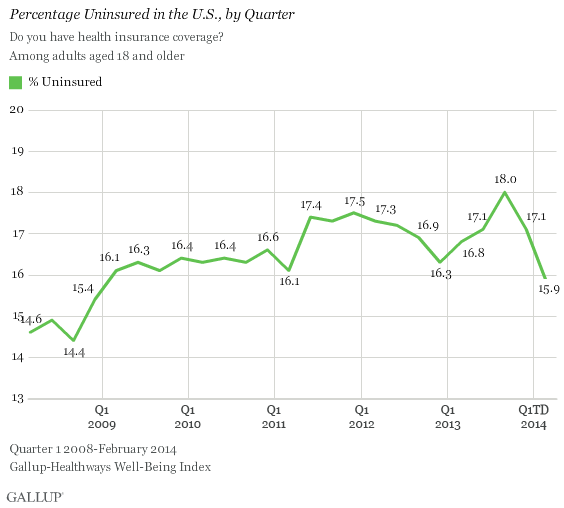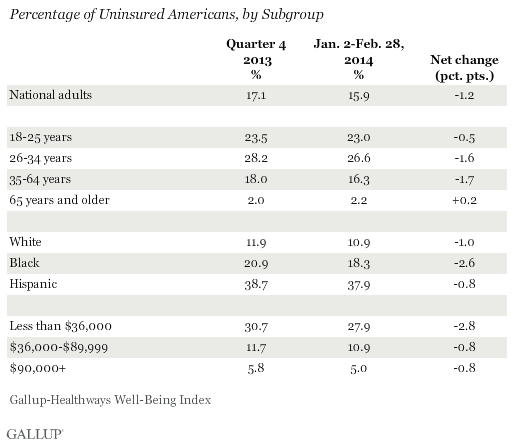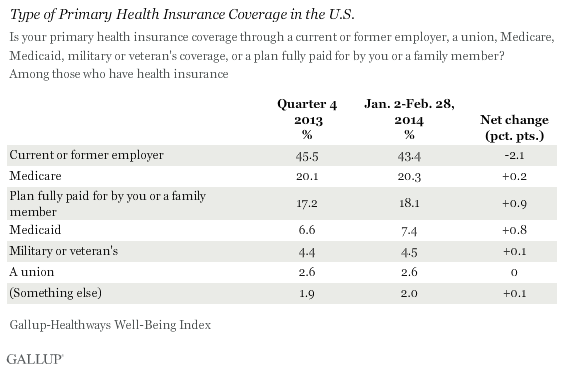WASHINGTON, D.C. -- The percentage of Americans without health insurance continues to fall, measuring 15.9% so far in 2014 compared with 17.1% in the fourth quarter of 2013.

These data are based on more than 28,000 interviews with Americans from Jan. 2-Feb. 28, 2014, as part of the Gallup-Healthways Well-Being Index. With only a few weeks remaining in the first quarter, the uninsured rate is on track to be the lowest quarterly level that Gallup and Healthways have measured since 2008.
The uninsured rate has been declining since the fourth quarter of 2013, after hitting an all-time high of 18.0% in the third quarter. The uninsured rate for the first quarter of 2014 so far includes a 16.2% reading for January and 15.6% for February.
Uninsured Rate Declines Most Among Lower-Income and Black Americans
The uninsured rate for almost every major demographic group has dropped in 2014 so far. The percentage of uninsured Americans with an annual household income of less than $36,000 has dropped the most -- by 2.8 percentage points -- to 27.9% since the fourth quarter of 2013, while the percentage of uninsured blacks has fallen 2.6 points to 18.3%. Hispanics remain the subgroup most likely to lack health insurance, with an uninsured rate of 37.9%.
The percentage of uninsured has declined across all age groups this year, except for those aged 65 and older. The uninsured rate for that group has likely remained stable because most Americans aged 65 and older have Medicare.
The uninsured rate among 26- to 34-year olds and 35- to 64-year olds continues to decline -- now at 26.6% and 16.3%, respectively. The February Enrollment Report released by the Department of Health and Human Services (HHS) highlighted no significant changes in young adults' enrollment in the health exchanges since its December report, with the cumulative total enrollment rate among 18- to 34-year-olds hovering at 25%. The Obama administration has made young adults' enrollment in a health insurance plan a top priority, as healthcare experts say 40% of new enrollees must be young and healthy for the Affordable Care Act to be successful.

Fewer Americans Get Primary Coverage Through Employer
The percentage of Americans who get insurance through a current or former employer fell nearly two points so far in the first quarter of 2014 to 43.4%. More Americans now say their primary health insurance coverage is through a plan fully paid for by themselves or a family member compared with at the end of 2013 -- 18.1% vs. 17.2%. The percentage who say they are covered primarily through Medicaid is also up slightly, likely because some states have chosen to expand Medicaid coverage.

Implications
The uninsured rate continues to decline after the requirement to have health insurance went into effect on Jan. 1, 2014. This drop could be a result of the ACA, which aims to provide healthcare coverage to more Americans through multiple provisions, including federal and state healthcare marketplaces where Americans can purchase health insurance coverage at competitive rates.
At the end of February, HHS reported 4 million people have signed up for health insurance coverage through the marketplaces established under the ACA. With the open enrollment period scheduled to close on March 31, the uninsured rate in the U.S. will likely continue to fall. Additionally, healthcare aides in the Obama administration announced on Wednesday that Americans will be able to renew old health insurance plans for up to three years, even if the plans do not comply with ACA policies. Other provisions of the healthcare law have not yet gone into effect, such as the requirement for employers to provide health insurance to their employees by 2015 or 2016. These provisions also may affect the uninsured rate over time.
Gallup will continue to track the U.S. uninsured rate in the weeks and months ahead.
Survey Methods
Results are based on telephone interviews conducted as part of the Gallup-Healthways Well-Being Index survey Jan. 2-Feb. 28, 2014, with a random sample of 28,396 adults, aged 18 and older, living in all 50 U.S. states and the District of Columbia.
For results based on the total sample of national adults, the margin of sampling error is ±1 percentage points at the 95% confidence level.
Interviews are conducted with respondents on landline telephones and cellular phones, with interviews conducted in Spanish for respondents who are primarily Spanish-speaking. Each sample of national adults includes a minimum quota of 50% cellphone respondents and 50% landline respondents, with additional minimum quotas by time zone within region. Landline and cellular telephone numbers are selected using random-digit-dial methods. Landline respondents are chosen at random within each household on the basis of which member had the most recent birthday.
Samples are weighted to correct for unequal selection probability, nonresponse, and double coverage of landline and cell users in the two sampling frames. They are also weighted to match the national demographics of gender, age, race, Hispanic ethnicity, education, region, population density, and phone status (cellphone only/landline only/both, and cellphone mostly). Demographic weighting targets are based on the most recent Current Population Survey figures for the aged 18 and older U.S. population. Phone status targets are based on the most recent National Health Interview Survey. Population density targets are based on the most recent U.S. census. All reported margins of sampling error include the computed design effects for weighting.
In addition to sampling error, question wording and practical difficulties in conducting surveys can introduce error or bias into the findings of public opinion polls.
For more details on Gallup's polling methodology, visit www.gallup.com.
